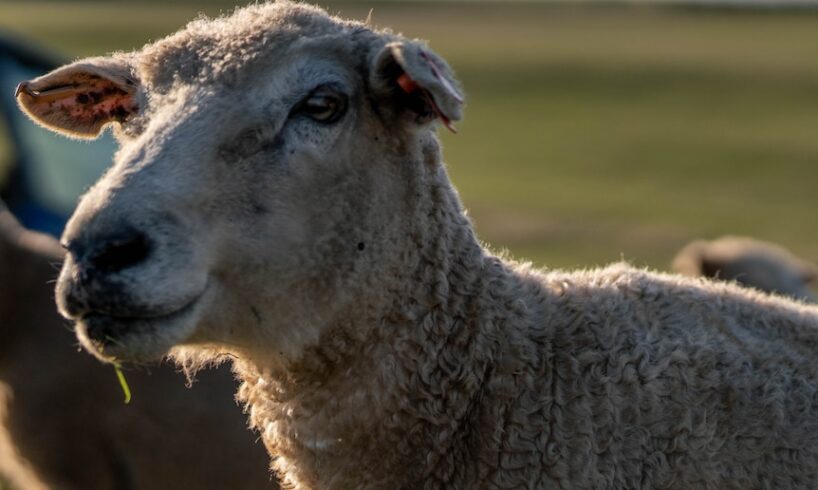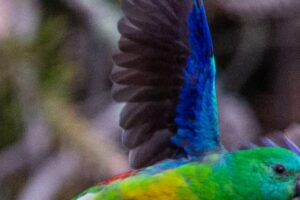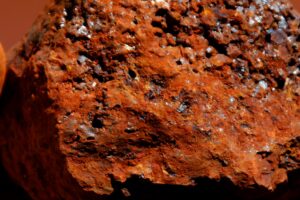
They may not have the same star power as their Merino cousins, but for a handful of dedicated breeders, English Leicesters hold a special place on their farm.
“Dad always used to say … the perfect English Leicester is just like a dining room table; a big, flat dining room table on four legs,” Tasmanian breeder Fiona Hume said.
On the banks of the Derwent River at Macquarie Plains, about 50 kilometres north-west of Hobart, you will find one of the country’s largest English Leicester flocks.
English Leicester sheep have been running on this Tasmanian farm since 1894. (ABC News: Ebony ten Broeke)
Ms Hume’s family have been running sheep here since 1894, and English Leicesters since the 1950s.
Because the wool does not fetch much, she admits the flock does not make a great deal of financial sense.
“We’ve never made any money from the English Leicesters. At the moment their wool is worth 20 cents a kilo,” she said.
“They’re kind of this thing that you just love.”
The wool is only worth 20 cents a kilo. (ABC News: Ebony ten Broeke)
It has been 200 years since the first documented English Leicesters were imported into Hobart from England.
Today, the heritage breed — with its big frame and lustrous long locks — is classified as vulnerable in Australia.
Brenton Heazlewood farms at Whitemore in northern Tasmania. (ABC Rural: Laurissa Smith)
That is because there are just 20 English Leicester breeders in Australia and roughly 500 registered sheep.
Brenton Heazlewood’s family has been contributing to those bloodlines for generations.
“We’ve had a stud since 1871 and I just want to keep that going,” he said.
The English Leicester sheep is the progenitor for the faster-maturing Border Leicester breed. (Supplied: Fiona Hume)
The president of the English Leicester Association of Australia is so passionate about the breed, he has released a book about their history.
“What surprised me when I started the research was that the Merino people that brought them in,” Mr Heazlewood said.
“They wanted to improve the carcass of the merino, but still retain the merino wool.”
The English Leicester breed was developed in England by agricultural pioneer Robert Bakewell in the late 1700s. (ABC News: Ebony ten Broeke)
The English Leicester was developed in England by agricultural pioneer Robert Bakewell in the late 1700s, coinciding with the industrial revolution.
He wanted an animal that grew a lot faster and with more meat than other breeds.
Alongside Merino sheep, English Leicesters hit their peak in Australia between the 1830s and the 1930s.
Owners say the rare breed has beautiful wool and plenty of attitude. (ABC: Margot Foster)
But numbers started to dwindle when their direct descendent, the faster-maturing Border Leicester, was introduced.
“In essence its decline was brought about because it was too good at improving other breeds,” Mr Heazlewood said.
And that is what Ms Hume has done, integrating them with her Suffolk sheep and crossing some with merinos to produce a small flock of good mothers.
Breeders say there is scope to grow the market for English Leicester wool. (ABC Rural: Laurissa Smith)
Craft market demand for wool
The breed is known for its long, high-lustre wool, sought after by spinners and weavers.
It is this craft market that is maintaining English Leicester numbers in countries such as Sweden and the United States.
But here in Australia, demand for the curly wool is limited.
The breed’s long fleece make it ideal for spinning and weaving. (ABC News: Laurissa Smith)
Ms Hume said there was certainly potential to grow the market.
“I think their sheepskins and wool are really great products and I think there is enormous scope to expand in that area,” she said.
“If I had more time, I could be selling a lot more English Leicester sheepskins.”
Fiona Hume believes there’s scope to expand the market for the breed. (ABC News: Ebony ten Broeke)
Next generation keeping breed alive
So who is stepping up to continue the legacy of the breed?
George Willows was just eight years old when he took on his grandfather’s English Leicester flock with the help of his dad, Paul.
Now 17, the young sheep farmer near Triabunna on Tasmania’s east coast is keen to see sheep numbers grow.
George Willows is dedicated to growing the genetics of the English Leicester breed in Tasmania. (ABC Rural: Laurissa Smith)
“They’re very gentle, nurturing sheep,” he said.
“I’ve been trying to improve the growth rates, but still keep true to the breed.
“A lot of breeds are built on the base of the Leicester, hopefully people see that and come back to the bloodlines.”
Ram wants a ewe
Mr Heazlewood is optimistic the breed’s future is in safe hands.
“It’s all very well, old people like me having it,” he said.
“But you need young people to keep it going and and we have got that young base.
“We’re very lucky here in Australia, there’s four or five young breeders interested in the breed.
“So I’m confident that this future is secure, there’s no doubt about that.”
Loading…
Source





